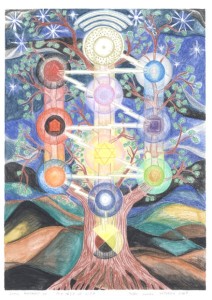 All of us are fundamentally creative, and contain within us the spark of spiritual “Eros” which impels us toward acts of creativity in our life. WHAT we create depends upon the cycles and patterns of creativity that we set up or built as habits. What I want to do in this article is outline the four basic stages of a creative cycle, and then reflect upon how we can go about using this understanding to become more positively creative in our life.
All of us are fundamentally creative, and contain within us the spark of spiritual “Eros” which impels us toward acts of creativity in our life. WHAT we create depends upon the cycles and patterns of creativity that we set up or built as habits. What I want to do in this article is outline the four basic stages of a creative cycle, and then reflect upon how we can go about using this understanding to become more positively creative in our life.
The four stages of a creative cycle
Stage 1 – The activation of latent Eros within ourselves– The first stage of a creative cycle is when the natural creative spiritual energy (Eros) within us becomes activated in some way. At this stage our creative energy has no form, it is pure potentiality that can become any number of things depending upon which way we direct it.
Stage 2 – The formation of images, thoughts and feelings within our creative imagination – The second stage of a creative cycle is when our imagination starts to build structures and images which our creative energy can then energize and animate. Whatever intentions, pictures, thoughts, beliefs perspectives and other mental structures that we habitually hold in our mind become energized by our natural inner creative energy.
Stage 3 – The formation of speech – Based upon the activity of our creative imagination, we then develop a sense of inhabiting a particular type of “reality”. In reality this “reality” is largely an imaginative construct that we project upon our outer world, but it appears to us to be quite real. Based upon this perception of a particular type of reality we then speak in such a way that affirms and confirms that reality. The statements “I can never find happiness” and “I am being challenged by my circumstances to create my own happiness” are both words that affirm a certain imagined reality, and re-enforce that “reality” to the person saying them. Here speech can refer to actual spoken words, or to the content of our daily “inner dialogue” that we have with ourselves in our mind each day.
Stage 4 – The creation of acts in the world– Based upon our imagination and speech we then engage in actions. These actions are physical articulations of our creative imagination and the content of our speech. We act in accordance with what we imagine, think and say to ourselves and other people.
Positive and Negative Creative Cycles
So, based on our understanding of the above we can see that what we choose to imagine and what we choose to say really determines the direction that our natural creative energy or Eros takes in our life. Negative and paranoid imagination and speech will create a negative and paranoid world. Life-affirming and positively directed imagination and speech will create a positively experienced and life affirming experience.
Some Practical Points to Begin Integrating
From the above insights we can see that our habitual imagination and speech play a crucial role in the reality that we sculpt and create from the “raw” creative energy that we have been given by the universe. With this in mind spending a few minutes a day over the next week asking yourself the following questions may be helpful:
1. What is my imagination building right now with the natural creative energy that it is being fed with from spirit?Is what it is building in my mind helping me or hindering me in my path to happiness and inner wellbeing?
2. What has my speech (outer or inner) over the last hour or two been showing me about the way I am expressing and manifesting the creative energy in my life?Is what I am saying helping me to bring more energy into my life, or is it limiting me unnecessarily?
3. How deeply am I aware of the power of my on creativity?In what ways can I begin to value and appreciate my innate creative power more?
© Toby Ouvry 2011, you are welcome to use or share this article, but please cite Toby as the source and include reference to his website www.tobyouvry.com

